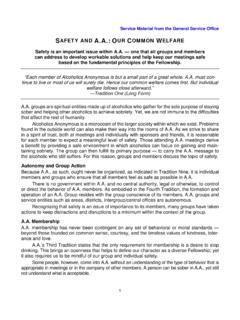Transcription of SAFETY MEETINGS AND COMMITTEE CHARTER - …
1 PROGRAM OVERVIEW. SAFETY MEETINGS AND COMMITTEE CHARTER SAFETY PROGRAM. REGULATORY STANDARD: State Regulations Some states require that companies with 20 or more employees have an active SAFETY COMMITTEE . INTRODUCTION: SAFETY MEETINGS provide the opportunity for employees and supervisors to engage in discussions on a variety of SAFETY topics. Effective MEETINGS promote cooperation and reinforce important SAFETY and health operating philosophies and practices at the company and foster commitment and participation by both employees and management in the company's SAFETY management program. TRAINING: None required ACTIVITIES: If required, establish a SAFETY COMMITTEE Meet on a regular basis (at least quarterly) to discuss SAFETY issues or concerns appropriate to the workplace Ensure notes are taken at COMMITTEE MEETINGS and actions and activities are documented.
2 Where corrective actions are required, ensure follow up is completed FORMS: If a COMMITTEE is required, meeting minutes or notes and any corrective actions must be documented Table of Contents 1. Purpose 2. Scope 3. Responsibilities 4. Procedure 5. SAFETY Information 6. Training Information & Requirements 7. Definitions SAFETY MEETINGS and COMMITTEE CHARTER SAFETY Program Page 1 of 7. Rev. [02/09]. SAFETY MEETINGS and COMMITTEE CHARTER SAFETY Program 1. Purpose. This program is designed to outline the format and process to enable supervisors, management, or a company SAFETY COMMITTEE to hold effective SAFETY discussions that provide SAFETY related information, and to hold COMMITTEE or group MEETINGS centered on SAFETY topics. 2. Scope. Applies to SAFETY related MEETINGS or SAFETY COMMITTEE MEETINGS held at the company.
3 Several state regulations require that companies with more than 20 employees set up a SAFETY COMMITTEE . 3. Responsibilities. Management/Supervisors: Support the SAFETY suggestions of the employees, as feasible. Support the creation of a SAFETY COMMITTEE . Communicate with the SAFETY COMMITTEE chairperson or with supervisors and other management on SAFETY issues and concerns. Assist in the development and implementation of solutions to SAFETY issues. Review this program and the status of SAFETY actions taken at least annually. Hold regularly scheduled discussions with employees on SAFETY topics. At a minimum, SAFETY discussions will be held with employees: Upon initial job assignment or reassignment. A well-planned and well- executed SAFETY orientation forms the foundation for each individual's future SAFETY and health performance.
4 Each supervisor should ensure that new employees receive a copy of specific safe work practices and procedures, as appropriate to the job or position. When workplace changes occur that require updated information. Process changes, new materials or changes to existing procedures or equipment may prompt a SAFETY discussion on how to safely use or handle the material or equipment. When new jobs or tasks are planned. Discussion involving work being planned should include listing potential hazards, developing suggested engineering approaches to reduce risk, identifying SAFETY equipment to be used, and developing basic safe operating procedures. When a workplace injury or incident occurs. Discussion should focus on the facts surrounding the incident, the injury, and the various causes that allowed the incident to occur, rather than on the injury or illness itself.
5 Medical privacy concerns may need to be considered during discussions. SAFETY MEETINGS and COMMITTEE CHARTER SAFETY Program Page 2 of 7. Rev. [02/09]. When employee behaviors are noted that require a SAFETY discussion. Discussion of a failure to adhere to a SAFETY procedure should cover why such a behavior is wrong, the potential hazards, and constructive discussion on how to correctly follow procedures. When defective tools or equipment are identified (by employees or the manufacturer). When regulatory changes require updated information. Employees: Follow established SAFETY procedures. Report SAFETY issues, concerns or violations to your supervisor. Participate, as needed or required, in SAFETY MEETINGS . Participate, if appropriate, on the SAFETY COMMITTEE . SAFETY Officer (as needed or required): Assist in the development and implementation of this program.
6 SAFETY COMMITTEE (as needed or required): Meet at least quarterly to discuss SAFETY issues and needs at the company. Monthly MEETINGS are recommended. Keep discussions pertinent and productive. Complete any action items assigned. Perform incident reviews, inspections or audits, if appropriate. SAFETY COMMITTEE Chairperson (as needed or required): Maintain a current listing of SAFETY COMMITTEE membership. Schedule MEETINGS with COMMITTEE membership at least quarterly. Monthly MEETINGS are recommended. Set the discussion topics or agenda for the meeting . Facilitate the meeting , keeping the discussion pertinent and productive. Take meeting notes, or designate another member as note-taker. Distribute meeting notes to COMMITTEE members and, as appropriate, to management. SAFETY MEETINGS and COMMITTEE CHARTER SAFETY Program Page 3 of 7.
7 Rev. [02/09]. Assure action items assigned at the MEETINGS are tracked and completed. Enlist management assistance, as needed or required. 4. Procedure. Supervisory and Employee Discussions: Supervisors, in conjunction with management and/or the company's SAFETY Officer or SAFETY COMMITTEE will conduct regular MEETINGS with employees on various SAFETY topics. The level of detail required to ensure that the information is relevant to the employees is determined by the supervisor. SAFETY briefings will be provided at least quarterly. Discussions may be more frequently conducted ( monthly or weekly), based on the type of business and workplace hazards. SAFETY discussions may be held as a part of routine group MEETINGS , or as part of routine job inspections, procedure reviews or within job hazard analysis review.
8 In this situation, 10-15 minutes should provide sufficient time for a review of a specific topic or procedure. Formal MEETINGS devoted solely to SAFETY topics may include: An explanation of the objectives of the meeting or training. A breakdown of the points or part of the procedure, identifying each key step, and the SAFETY measure for each step. Using a demonstration of proper methods rather than a verbal explanation. Principal Activities of the SAFETY COMMITTEE : Assemble at least quarterly (monthly is recommended) to conduct SAFETY MEETINGS . Discuss and report on unfinished business or action items from previous MEETINGS . Discuss new business, issues or concerns. Maintain records of MEETINGS (notes or meeting minutes are recommended). If appropriate to the business of the company, or at management direction, the following additional duties may be performed by the COMMITTEE : Direct and monitor group or departmental SAFETY MEETINGS .
9 Direct and monitor employee SAFETY training needs and requirements. SAFETY MEETINGS and COMMITTEE CHARTER SAFETY Program Page 4 of 7. Rev. [02/09]. Perform or oversee departmental SAFETY inspections. Review accident/injury information and discuss corrective actions. 5. SAFETY Information. SAFETY COMMITTEE CHARTER : The SAFETY COMMITTEE will encourage SAFETY awareness among all employees. It will be established to monitor SAFETY performance, SAFETY inspections, and aid the SAFETY Officer and management in administering the SAFETY program. The COMMITTEE is charged to: Discuss strategies to reduce incidents. Assist in implementing corrective or preventive actions to increase SAFETY and reduce hazards. Be aware of conditions in all work areas that can produce injuries. Aid the company in complying with all applicable laws and regulations pertaining to SAFETY .
10 Assist in assuring that no employee is required to work at a job that is not safe or healthful. The SAFETY and health of each employee is of primary importance to the company. Assist management in making recommendations for tools, equipment, and controls for SAFETY and health in keeping with the highest standards. Assist in maintaining a SAFETY and health program conforming to the best management practices of our industry or market segment. Assist in establishing a SAFETY management program that instills the proper attitudes toward injury and illness prevention not only on the part of employees, but also between each employee and his or her co-workers. SAFETY COMMITTEE Composition: The SAFETY COMMITTEE is, primarily, a voluntary group. There are occasions when management may appoint members.






